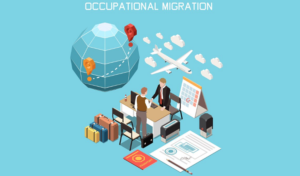The State of the US Economy A Look at Key Indicators and Trends
The US economy’s state is constantly a contentious issue, especially in light of recent occurrences like the COVID-19 outbreak and its effects on both businesses and people. It’s critical to keep up with the most recent trends and indicators whether you’re a business owner, investor, or simply someone who is interested in the status of the economy.
We’ll delve deeply into the main trends and indicators of the US economy in this post, including the GDP, unemployment rate, consumer price index (CPI), Federal Reserve policies, and foreign trade. We’ll look at how these indicators have changed through time, where they are now, and how recent events have affected the US economy. You will have a thorough understanding of the US economy’s state and what it means for you by the end of this article.
Don’t worry though; we won’t waste your time with meaningless data and economic jargon. Even non-economists can understand the information because of the entertaining and amusing way it will be delivered. Grab a cup of coffee, and let’s examine the US economy in more detail.
GDP, or gross domestic product
The most popular way to gauge a nation’s economic performance is by its GDP. It is an estimate of the total value of products and services produced inside the boundaries of a nation over a specific time frame, usually a year. Because it represents both the degree of economic activity and the population’s standard of living, GDP is a crucial indication of the health of the economy.
The US GDP has been fluctuating in recent years, with a significant decline in 2020 as a result of the COVID-19 pandemic and a significant increase in 2021. The US GDP increased from $21.6 trillion in 2019 to $22.7 trillion in 2021, per the most recent statistics. Strong government stimulus measures, an increase in company investment, and a spike in consumer spending all contributed to this expansion.
However, a wide range of factors, such as governmental policies, global commerce, technical breakthroughs, and demographic changes, have an impact on GDP growth. Any one of these slowdowns could cause the GDP to decrease. For instance, a decline in investment or consumer expenditure can cause the GDP to fall. Both policymakers and investors need to understand the elements that affect GDP growth or contraction in order to make informed judgments about economic policy and investment strategies.
Rate of Unemployment
An important gauge of the state of the labor market and the economy at large is the unemployment rate. It calculates the proportion of the labor force that is unemployed and looking for work. A low unemployment rate can signify a strong economy with employment prospects, whereas a high unemployment rate can signify a weak labor market and probable economic issues.
Over the years, there have been major changes in the unemployment rate in the US. The most recent figures show that the US unemployment rate was 4.2% in January 2022, down from a peak of 14.8% in April 2020, when the recession brought on by the epidemic was at its worst. This development is a result of the labor market gradually improving as businesses started to reopen and hiring increased.
The reasons for variations in the unemployment rate in the US are complicated and might include things like modifications to economic policy, alterations in the demand for labor, and international occurrences like pandemics or recessions. Low unemployment rates can result in increased competition for workers and potential wage inflation, whereas high unemployment rates can have substantial effects on the economy, including decreased consumer spending and tax collections. Employers and policymakers who make decisions that affect the labor market and the economy as a whole must have a thorough understanding of the factors that affect fluctuations in the unemployment rate.
% of inflation
The general rise in prices of goods and services over time that lowers the purchasing power of money is referred to as inflation. Because it can limit consumer spending and erode savings, inflation can have a big effect on the economy and consumers. This results in slower economic growth.
According to the most recent data, the US inflation rate increased from 2.3% in December 2019 to 7% in December 2021. Disruptions in the supply chain and high demand as the economy recovered from the pandemic are the main causes of this spike in prices.
Complex factors, including shifting consumer demand, varying commodity prices, and shifting monetary conditions, can all contribute to inflation. The US government and Federal Reserve have pursued a number of initiatives to fight inflation, including raising interest rates and tightening the money supply. These measures are intended to reduce inflationary pressures and restrict economic development. The difficulties of controlling inflation in a dynamic economy are highlighted by the potential detrimental consequences these measures may have on employment and economic growth.
Customer Assurance
Consumer confidence is a measure of how optimistic individuals are about both their own financial status and the state of the economy as a whole. Consumer spending, which accounts for a major component of the US economy, is directly tied to it. Consumers are more likely to spend money and encourage economic growth when they have confidence in the economy.
According to the most recent data, the US consumer confidence index declined from a peak of 137.9 in February 2020 before the pandemic to 87.4 in January 2022. This decline is a result of the pandemic’s persistent uncertainty and its effects on the economy.
Changes in monetary policy, stock market swings, and world calamities like pandemics or geopolitical crises can all have an impact on consumer confidence. Because it might result in lower consumer spending and subsequent economic difficulties, a decline in consumer confidence can have a big impact on firms. In order to sustain economic growth and stability, businesses and governments must fully understand the elements that affect consumer confidence.
Trade internationally
The US economy depends heavily on international trade because it gives companies access to new markets and gives consumers access to a greater variety of goods and services. Trade also makes it easier for money and technology to move across international borders, which can foster innovation and economic progress.
According to the most recent figures, the US trade deficit increased from negative $576.9 billion in 2019 to negative $676.7 billion in 2021. This gap reflects the fact that the US imports more products and services than it exports, which can affect the economy both favorably and unfavorably.
commerce policies and world events can have a big impact on US commerce. The movement of goods and services can be affected by tariffs, quotas, and other trade restrictions, which can raise costs for both firms and consumers. Global occurrences like pandemics, natural disasters, and geopolitical conflicts can potentially affect the US economy and hinder international trade. For policymakers and businesses navigating the global economy, it is critical to comprehend how trade policies and global events affect US commerce.
Conclusion
The several significant indicators and trends we’ve looked at in this article show that the US economy is complex and continually changing. While there is little doubt that the COVID-19 pandemic has had a considerable impact on the economy, there are also long-term patterns and policies that have influenced its course.
There are still grounds for hope despite obstacles including a high unemployment rate and inflationary pressures. The Federal Reserve has put policies in place to help the economy, and the US GDP has recovered from its epidemic lows. The US economy continues to be significantly impacted by international trade, notwithstanding some policy and agreement uncertainty.
Individuals and companies should place a high priority on adaptability and resilience when navigating the current economic environment. This entails looking for possibilities in emerging industries, keeping a varied portfolio, and keeping up with current trends and regulations in the economy. Additionally, it’s critical to maintain financial proactivity and, as needed, seek out assistance and resources.
Overall, the US economy has chances for growth and success even though there may be difficulties and uncertainties in the future. People and businesses can handle the current environment and set themselves up for long-term success by remaining knowledgeable and adaptive.
Read More You May Like:














Post Comment